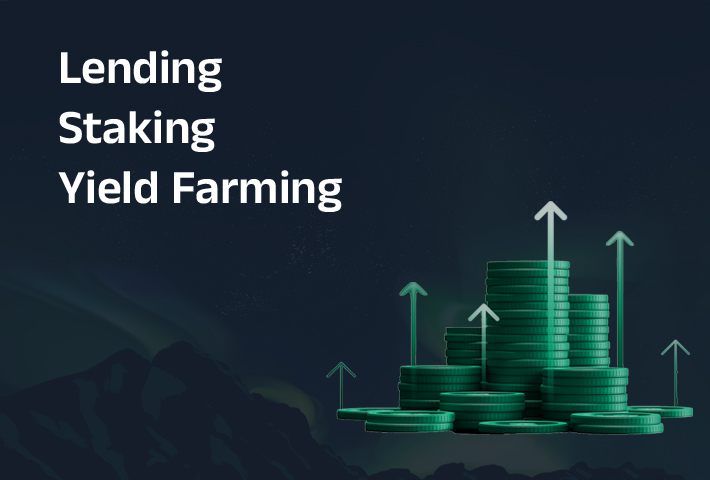In the rapidly evolving landscape of Decentralized Finance (DeFi), opportunities to earn passive income have taken center stage. Lending, staking, and yield farming are three key mechanisms that allow users to put their crypto assets to work. This blog post dives deep into these concepts, explaining what they are, how they work, and their role in the DeFi ecosystem. Whether you’re a beginner or a seasoned crypto enthusiast, this guide will help you navigate these powerful tools.
Table of Contents
Overview of DeFi Opportunities
Decentralized Finance (DeFi) has revolutionized how we interact with financial systems by removing intermediaries and leveraging blockchain technology. Lending, staking, and yield farming are among the most popular ways to generate returns on crypto holdings in DeFi. These mechanisms allow users to earn interest, rewards, or fees while contributing to the liquidity and security of decentralized networks. With platforms like Aave, Uniswap, and Curve leading the charge, DeFi offers a dynamic environment for investors seeking to maximize their assets’ potential.
What Are Lending, Staking, and Yield Farming?
Lending
Lending in DeFi involves providing your crypto assets to a protocol where others can borrow them in exchange for paying interest. These platforms operate without intermediaries, using smart contracts to automate the process.
Staking
Staking refers to locking up your cryptocurrency in a proof-of-stake (PoS) blockchain to support network operations like transaction validation. In return, stakers earn rewards, typically in the form of additional tokens.
Yield Farming
Yield farming involves strategically deploying crypto assets across DeFi protocols to earn the highest possible returns. Farmers often provide liquidity to decentralized exchanges (DEXs) or lending platforms, earning fees or governance tokens.
This fundamental change in how banks and other financial services work doesn’t just boost efficiency. It also makes financial tools available to everyone, allowing people all over the world to use them with just internet access, effectively turning DeFi into a global, non-custodial defi bank.
How Lending Works in DeFi
DeFi lending platforms like Aave and Compound allow users to deposit their crypto into liquidity pools. These pools are then accessible to borrowers who pay interest on their loans. Smart contracts govern the terms, ensuring transparency and automation. Lenders earn interest based on the pool’s utilization rate, which fluctuates with demand.
Example: You deposit 1 ETH into Aave’s lending pool. Borrowers pay 5% annual interest to access the pool. You earn a portion of that interest proportional to your contribution.
How Staking Works in DeFi
In staking, users lock their tokens in a PoS blockchain or DeFi protocol to help secure the network or enable governance. For instance, staking ETH on Ethereum 2.0 involves running a validator node or delegating tokens to a staking pool. Rewards are distributed based on the amount staked and the network’s rules.
Example: You stake 100 ADA in Cardano’s network. The protocol rewards you with 4% annual returns in ADA for supporting network consensus.
How Yield Farming Works in DeFi
Yield farming is more complex, often involving providing liquidity to DEXs like Uniswap or Curve. Users deposit token pairs into liquidity pools, enabling trading and earning a share of transaction fees. Many protocols also distribute governance tokens as incentives, which can be sold or staked for additional returns.
Example: You provide $1,000 worth of ETH and USDT to a Uniswap liquidity pool. You earn 0.3% of every trade’s fees plus UNI tokens as a reward.
Key Differences Between Lending, Staking, and Yield Farming
When we look at DeFi side by side with the traditional financial system, we see some significant differences:
Lending
Lending involves lending assets to earn stable interest rates, typically on platforms like Aave and Compound. The risk level is moderate, depending on the protocol's reliability, and the complexity is low, making it accessible for beginners.
Staking
Staking secures a network to earn fixed or variable rewards, often on platforms like Ethereum and Cardano. It carries a low to moderate risk, primarily from slashing, and has a low to moderate complexity, appealing to those comfortable with network participation.
Yield Farming
Yield Farming requires providing liquidity to earn fees or rewards, commonly on Uniswap and Curve, with potentially high but variable returns. It involves high complexity and significant risks, including impermanent loss and volatility, making it suitable for experienced users.
Benefits and Risks of These DeFi Mechanisms
Benefits
Passive Income: All three methods offer ways to earn returns without active trading.
Accessibility: DeFi platforms are open to anyone with an internet connection.
Transparency: Smart contracts ensure clear, auditable terms.
Innovation: Yield farming, in particular, drives new financial strategies.
Risks
Smart Contract Bugs: Vulnerabilities can lead to fund losses.
Market Volatility: Crypto price swings affect returns and collateral.
Impermanent Loss: Yield farmers may lose value due to price divergence in liquidity pools.
Regulatory Uncertainty: Evolving laws may impact DeFi operations.
Slashing: Stakers risk penalties for network misbehavior.
The Future of Lending, Staking, and Yield Farming
The DeFi space is poised for growth, with advancements in:
Scalability: Layer 2 solutions like Arbitrum reduce transaction costs.
User Experience: Simplified interfaces make DeFi more accessible.
Cross-Chain Integration: Bridges enable assets to move across blockchains.
Regulation: Clearer frameworks could boost institutional adoption.
Innovation: New protocols may offer higher yields or lower risks.
Most Common FAQ
Lending is relatively safe on audited platforms like Aave, but risks like smart contract bugs persist. Always research protocols.
It varies by network. For example, Ethereum requires 32 ETH for solo staking, but pools allow smaller amounts.
Yes, due to impermanent loss, market volatility, or protocol hacks.
Look for audited smart contracts, strong community support, and transparent governance.
No, returns depend on market conditions and protocol performance.
Practical Use Cases
Lending: Ideal for conservative investors seeking stable interest.
Staking: Suits long-term holders who believe in a blockchain’s future.
Yield Farming: Attracts risk-tolerant users chasing high returns.
Diversification: Combining all three can balance risk and reward.
Liquidity Provision: Yield farming supports DEXs, enabling decentralized trading.
Conclusion
Lending, staking, and yield farming are pillars of DeFi, offering diverse ways to earn returns on crypto assets. While lending provides steady interest, staking supports blockchain security, and yield farming unlocks high-yield opportunities. However, each comes with risks that require careful consideration. As DeFi matures, these mechanisms will likely become more user-friendly and integrated into broader financial systems, making them essential tools for crypto investors.
Next Steps
Explore Platforms: Check out Aave for lending, Lido for staking, or Uniswap for yield farming.
Stay Informed: Follow DeFi Pulse or X posts for market trends.
Start Small: Test these strategies with small amounts to understand their mechanics.
Secure Your Assets: Use hardware wallets and reputable protocols to protect your funds.
By embracing these DeFi tools, you can take control of your financial future in a decentralized world.
Keep in mind: The cornerstone of decentralized trading is the adage, ‘If you don’t control the keys, you don’t truly own the cryptocurrency.’ Protecting your digital assets through robust, self-custodial methods not only secures your investments but also lays the groundwork for enduring prosperity in the crypto space.
Enhance your platform with Instaswap’s powerful integration solutions. Utilize our Trading API and customizable widgets to provide your users with a seamless decentralized trading experience—complete with secure, instant crypto swaps and efficient cross chain swaps. Embrace this next-generation API trading platform and watch your digital asset portfolio grow as you take advantage of the latest innovations in blockchain technology, DeFi protocols, and high-frequency trading. With features comparable to popular platforms like the Kraken API and support for multi-exchange trading, Instaswap offers a comprehensive solution for modern cryptocurrency trading needs.


